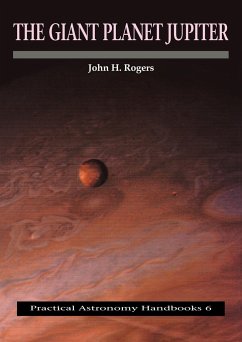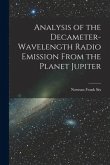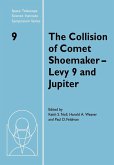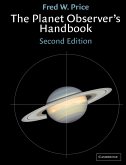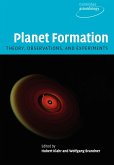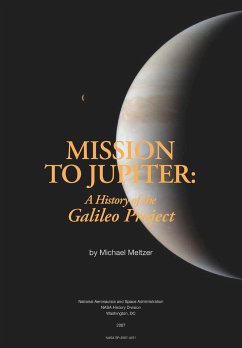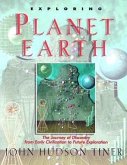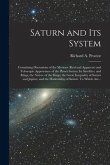John H. Rogers
The Giant Planet Jupiter
John H. Rogers
The Giant Planet Jupiter
- Broschiertes Buch
- Merkliste
- Auf die Merkliste
- Bewerten Bewerten
- Teilen
- Produkt teilen
- Produkterinnerung
- Produkterinnerung
This highly illustrated volume provides a comprehensive and accessible account of Jupiter and its satellites.
Andere Kunden interessierten sich auch für
![Analysis of the Decameter-wavelength Radio Emission From the Planet Jupiter Analysis of the Decameter-wavelength Radio Emission From the Planet Jupiter]() Norman Frank SixAnalysis of the Decameter-wavelength Radio Emission From the Planet Jupiter24,99 €
Norman Frank SixAnalysis of the Decameter-wavelength Radio Emission From the Planet Jupiter24,99 €![The Collision of Comet Shoemaker-Levy 9 and Jupiter The Collision of Comet Shoemaker-Levy 9 and Jupiter]() Keith S. Noll / Harold A. Weaver / Paul D. Feldman (eds.)The Collision of Comet Shoemaker-Levy 9 and Jupiter69,99 €
Keith S. Noll / Harold A. Weaver / Paul D. Feldman (eds.)The Collision of Comet Shoemaker-Levy 9 and Jupiter69,99 €![The Planet Observer's Handbook The Planet Observer's Handbook]() Fred William PriceThe Planet Observer's Handbook67,99 €
Fred William PriceThe Planet Observer's Handbook67,99 €![Planet Formation Planet Formation]() Planet Formation56,99 €
Planet Formation56,99 €![Mission to Jupiter Mission to Jupiter]() Michael MeltzerMission to Jupiter53,99 €
Michael MeltzerMission to Jupiter53,99 €![Exploring Planet Earth: The Journey of Discovery from Early Civilization to Future Exploration Exploring Planet Earth: The Journey of Discovery from Early Civilization to Future Exploration]() John TinerExploring Planet Earth: The Journey of Discovery from Early Civilization to Future Exploration12,99 €
John TinerExploring Planet Earth: The Journey of Discovery from Early Civilization to Future Exploration12,99 €![Saturn and Its System: Containing Discussions of the Motions (real and Apparent) and Telescopic Appearance of the Planet Saturn, Its Satellit Saturn and Its System: Containing Discussions of the Motions (real and Apparent) and Telescopic Appearance of the Planet Saturn, Its Satellit]() Saturn and Its System: Containing Discussions of the Motions (real and Apparent) and Telescopic Appearance of the Planet Saturn, Its Satellit25,99 €
Saturn and Its System: Containing Discussions of the Motions (real and Apparent) and Telescopic Appearance of the Planet Saturn, Its Satellit25,99 €-
-
-
This highly illustrated volume provides a comprehensive and accessible account of Jupiter and its satellites.
Hinweis: Dieser Artikel kann nur an eine deutsche Lieferadresse ausgeliefert werden.
Hinweis: Dieser Artikel kann nur an eine deutsche Lieferadresse ausgeliefert werden.
Produktdetails
- Produktdetails
- Verlag: Cambridge University Press
- Seitenzahl: 460
- Erscheinungstermin: 18. März 2009
- Englisch
- Abmessung: 297mm x 210mm x 25mm
- Gewicht: 1184g
- ISBN-13: 9780521115308
- ISBN-10: 0521115302
- Artikelnr.: 26222427
- Herstellerkennzeichnung
- Libri GmbH
- Europaallee 1
- 36244 Bad Hersfeld
- gpsr@libri.de
- Verlag: Cambridge University Press
- Seitenzahl: 460
- Erscheinungstermin: 18. März 2009
- Englisch
- Abmessung: 297mm x 210mm x 25mm
- Gewicht: 1184g
- ISBN-13: 9780521115308
- ISBN-10: 0521115302
- Artikelnr.: 26222427
- Herstellerkennzeichnung
- Libri GmbH
- Europaallee 1
- 36244 Bad Hersfeld
- gpsr@libri.de
Part I. Observing Jupiter: 1. Observations from Earth
2. Observations from spacecraft
Part II. The Visible Structure of the Atmosphere: 3. Horizontal structure: belts, currents, spots and storms
4. Vertical structure: colours and clouds
Part III. The Observational Record of the Atmosphere: 5. The Polar Region
6. North North Temperate Regions (57°N to 35°N)
7. North Temperate Region (35°N to 23°N)
8. North Tropical Region (23°N to 9°N)
9. Equatorial Region (9°N to 9°S)
10. South Tropical Region (9°S to 27°S)
11. South Temperate Region (27°S to 37°S)
12. South South Temperate Region (37°S to 53°S)
Part IV: The Physics and Chemistry of the Atmosphere: 13. Possible large-scale and long-term patterns
14. The dynamics of individual spots
15. Theoretical models of the atmosphere
16. The composition of the planet
Part V. The Electrodynamic Environment of Jupiter: 17. Lights in the Jovian night
18. The magnetosphere and radiation belts
Part VI. The Satellites: 19. The inner satellites and the ring
20. The Galilean satellites
21. Io
22. Europa
23. Ganymede
24. Callisto
25. The outer satellites
Appendices: 1. Measurement of longitude
2. Measurement of latitude
3. Lists of apparitions and published reports
4. Bibliography (The planet)
5. Bibliography (The magnetosphere and satellites)
Index.
2. Observations from spacecraft
Part II. The Visible Structure of the Atmosphere: 3. Horizontal structure: belts, currents, spots and storms
4. Vertical structure: colours and clouds
Part III. The Observational Record of the Atmosphere: 5. The Polar Region
6. North North Temperate Regions (57°N to 35°N)
7. North Temperate Region (35°N to 23°N)
8. North Tropical Region (23°N to 9°N)
9. Equatorial Region (9°N to 9°S)
10. South Tropical Region (9°S to 27°S)
11. South Temperate Region (27°S to 37°S)
12. South South Temperate Region (37°S to 53°S)
Part IV: The Physics and Chemistry of the Atmosphere: 13. Possible large-scale and long-term patterns
14. The dynamics of individual spots
15. Theoretical models of the atmosphere
16. The composition of the planet
Part V. The Electrodynamic Environment of Jupiter: 17. Lights in the Jovian night
18. The magnetosphere and radiation belts
Part VI. The Satellites: 19. The inner satellites and the ring
20. The Galilean satellites
21. Io
22. Europa
23. Ganymede
24. Callisto
25. The outer satellites
Appendices: 1. Measurement of longitude
2. Measurement of latitude
3. Lists of apparitions and published reports
4. Bibliography (The planet)
5. Bibliography (The magnetosphere and satellites)
Index.
Part I. Observing Jupiter: 1. Observations from Earth
2. Observations from spacecraft
Part II. The Visible Structure of the Atmosphere: 3. Horizontal structure: belts, currents, spots and storms
4. Vertical structure: colours and clouds
Part III. The Observational Record of the Atmosphere: 5. The Polar Region
6. North North Temperate Regions (57°N to 35°N)
7. North Temperate Region (35°N to 23°N)
8. North Tropical Region (23°N to 9°N)
9. Equatorial Region (9°N to 9°S)
10. South Tropical Region (9°S to 27°S)
11. South Temperate Region (27°S to 37°S)
12. South South Temperate Region (37°S to 53°S)
Part IV: The Physics and Chemistry of the Atmosphere: 13. Possible large-scale and long-term patterns
14. The dynamics of individual spots
15. Theoretical models of the atmosphere
16. The composition of the planet
Part V. The Electrodynamic Environment of Jupiter: 17. Lights in the Jovian night
18. The magnetosphere and radiation belts
Part VI. The Satellites: 19. The inner satellites and the ring
20. The Galilean satellites
21. Io
22. Europa
23. Ganymede
24. Callisto
25. The outer satellites
Appendices: 1. Measurement of longitude
2. Measurement of latitude
3. Lists of apparitions and published reports
4. Bibliography (The planet)
5. Bibliography (The magnetosphere and satellites)
Index.
2. Observations from spacecraft
Part II. The Visible Structure of the Atmosphere: 3. Horizontal structure: belts, currents, spots and storms
4. Vertical structure: colours and clouds
Part III. The Observational Record of the Atmosphere: 5. The Polar Region
6. North North Temperate Regions (57°N to 35°N)
7. North Temperate Region (35°N to 23°N)
8. North Tropical Region (23°N to 9°N)
9. Equatorial Region (9°N to 9°S)
10. South Tropical Region (9°S to 27°S)
11. South Temperate Region (27°S to 37°S)
12. South South Temperate Region (37°S to 53°S)
Part IV: The Physics and Chemistry of the Atmosphere: 13. Possible large-scale and long-term patterns
14. The dynamics of individual spots
15. Theoretical models of the atmosphere
16. The composition of the planet
Part V. The Electrodynamic Environment of Jupiter: 17. Lights in the Jovian night
18. The magnetosphere and radiation belts
Part VI. The Satellites: 19. The inner satellites and the ring
20. The Galilean satellites
21. Io
22. Europa
23. Ganymede
24. Callisto
25. The outer satellites
Appendices: 1. Measurement of longitude
2. Measurement of latitude
3. Lists of apparitions and published reports
4. Bibliography (The planet)
5. Bibliography (The magnetosphere and satellites)
Index.

